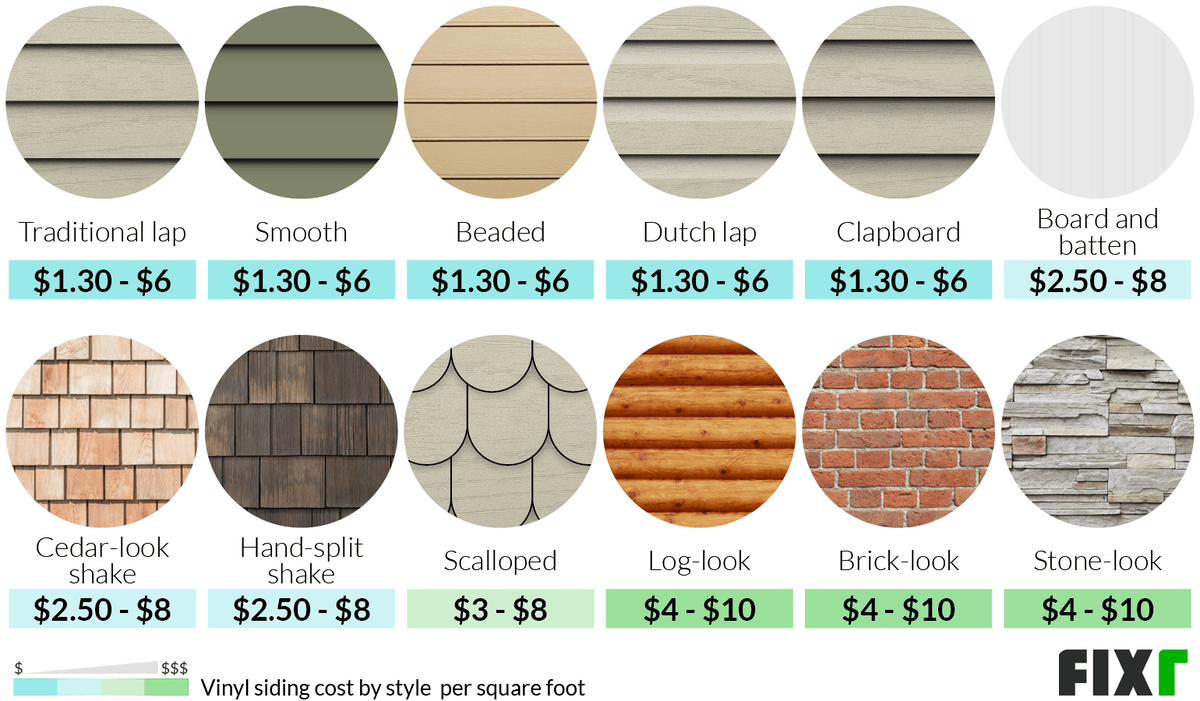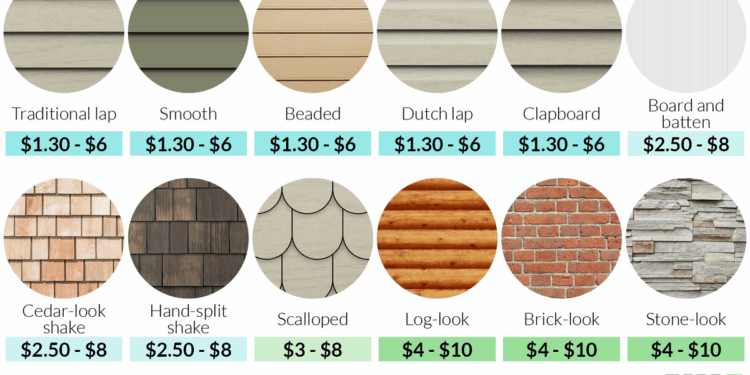Delving into the realm of vinyl siding costs opens up a world of factors and comparisons that can influence your decision-making process. From material quality to installation considerations, this guide will navigate you through the intricacies of siding vinyl cost.
As we explore the various aspects of vinyl siding costs, you'll gain valuable insights into how this choice can impact your budget and long-term maintenance plans.
Factors Affecting Vinyl Siding Cost
When considering the cost of vinyl siding, several key factors come into play. These factors can significantly impact the overall price of the project. Let's take a closer look at how material quality, style, color options, and installation complexity can influence the cost of vinyl siding.
Material Quality
The quality of the vinyl siding material can have a major impact on the cost. Higher quality materials are often more durable, have better insulation properties, and come with longer warranties. While these premium materials may cost more upfront, they can provide cost savings in the long run by reducing maintenance and repair expenses.
Style and Color Options
The style and color of the vinyl siding can also affect the overall cost. Certain styles, such as shake or scallop, may be more expensive than traditional horizontal panels. Similarly, custom colors or specialized finishes can increase the price of the siding.
It's important to consider your preferences and budget when selecting the style and color of your vinyl siding.
Installation Complexity
The complexity of the installation process can impact the cost of vinyl siding. Factors such as the size and shape of your home, existing structural issues, and the need for additional insulation or moisture barriers can all contribute to the overall cost.
A more complex installation may require more labor and materials, resulting in a higher price tag.Overall, the cost of vinyl siding can vary based on these factors and more. By understanding how material quality, style, color options, and installation complexity influence pricing, you can make informed decisions when planning your siding project.
Cost Comparison with Other Siding Materials

When considering siding options for your home, it's important to compare the costs of different materials to make an informed decision. Vinyl siding is a popular choice due to its affordability and low maintenance, but how does it stack up against other common siding materials like wood, fiber cement, and metal?
Wood Siding
Wood siding is known for its natural beauty and classic appeal, but it comes with a higher price tag compared to vinyl siding. The initial cost of wood siding can be significantly more expensive, and ongoing maintenance and painting can add up over time.
While wood siding may offer a timeless look, it may not be the most cost-effective option in the long run.
Fiber Cement Siding
Fiber cement siding is a durable and low-maintenance option that can mimic the look of wood or other materials. While fiber cement siding may have a similar initial cost to vinyl siding, installation costs can be higher due to its heavier weight and specialized tools required.
Additionally, fiber cement siding may require occasional painting or recaulking, adding to the overall cost over time.
Metal Siding
Metal siding, such as aluminum or steel, is another alternative to consider. While metal siding can be durable and resistant to pests and rot, it may come with a higher upfront cost compared to vinyl siding. Metal siding can also dent or scratch more easily, requiring repairs that can add to the overall cost.
Additionally, metal siding may not offer the same variety of styles and colors as vinyl siding.Overall, when comparing the cost of vinyl siding with other materials, vinyl siding tends to be a more cost-effective option. Its lower initial cost, minimal maintenance requirements, and long-term durability make it an attractive choice for homeowners looking to save on siding expenses in the long run.
Installation Costs and Considerations

Installing vinyl siding involves a specific process that can impact the overall cost of the project. Understanding the labor costs and considering ways to reduce installation expenses are essential for homeowners looking to install vinyl siding.
Typical Installation Process
- Preparation: This includes removing old siding, repairing any damaged areas, and preparing the surface for installation.
- Installation: The siding panels are carefully placed and secured to the exterior of the home, ensuring a proper fit and alignment.
- Trim Work: Adding trim pieces, corners, and other finishing touches to complete the look of the siding.
- Clean Up: Proper disposal of debris and cleaning the area after installation is crucial for a clean finish.
Labor Costs
- Labor costs typically account for a significant portion of the total project cost when installing vinyl siding.
- Factors that influence labor costs include the size of the project, complexity of the installation, and the contractor's experience and reputation.
- On average, labor costs for vinyl siding installation can range from $1 to $3 per square foot.
Tips to Reduce Installation Costs
- Get multiple quotes from different contractors to compare prices and services offered.
- Consider DIY installation for smaller projects if you have the necessary skills and tools.
- Opt for off-season installation when contractors may offer discounts to fill their schedules.
- Choose a reputable contractor with experience in vinyl siding installation to ensure quality workmanship and avoid costly repairs in the future.
Maintenance and Repair Costs
Maintaining and repairing vinyl siding is essential to ensure its longevity and appearance. By understanding the maintenance requirements and common repair issues, homeowners can effectively manage the costs associated with vinyl siding over time.
Maintenance Requirements
Proper maintenance of vinyl siding involves regular cleaning to remove dirt, dust, and mold that can accumulate on the surface. This can be done using a mixture of water and mild detergent, along with a soft brush or cloth. Inspecting the siding for any signs of damage, such as cracks or loose panels, is also important to address issues promptly and prevent further damage.
Common Repair Issues
Some common repair issues with vinyl siding include cracks, holes, warping, and fading. Repairing these issues may require replacing individual panels or sections of the siding, which can incur costs for materials and labor. Additionally, addressing issues like mold growth or pest infestations may also require professional assistance to ensure proper remediation.
Minimizing Repair Costs
Proper maintenance practices, such as regular cleaning and inspections, can help minimize the need for costly repairs. Addressing small issues promptly before they escalate can prevent more extensive damage and the associated repair costs. By investing time and effort in maintaining vinyl siding, homeowners can prolong its lifespan and reduce long-term repair expenses.
Outcome Summary
In conclusion, understanding the nuances of vinyl siding costs is crucial for making informed choices about your home exterior. By weighing factors, comparisons, and maintenance considerations, you can ensure that your investment in vinyl siding is both cost-effective and aesthetically pleasing.
Essential FAQs
What are the main factors influencing vinyl siding cost?
The main factors include material quality, style choices, color options, and installation complexity.
How does the cost of vinyl siding compare to other materials like wood and fiber cement?
Vinyl siding is often more cost-effective than wood or fiber cement, offering potential savings in the long run.
What are some tips for reducing installation costs when choosing vinyl siding?
Homeowners can reduce costs by getting multiple quotes, choosing simpler styles, and considering DIY options for installation.
What maintenance requirements should I consider for vinyl siding?
Regular cleaning and inspections can help prevent costly repairs in the future. Avoid harsh chemicals and use gentle cleaning solutions.
How can proper maintenance help minimize repair costs for vinyl siding?
Timely repairs of small issues can prevent larger, more expensive problems down the line. Regular inspections and upkeep are key.


